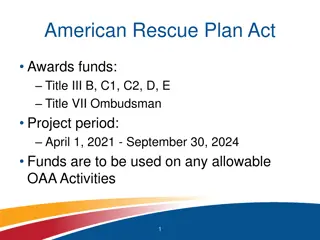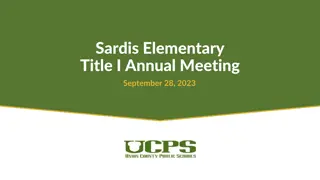Wagner-Peyser Title III Overview
Wagner-Peyser Title III, established in 1933, aims to create a national employment system to assist job seekers and businesses. It provides job search and placement services, counseling, recruitment services, and labor market information, among other activities. The program also focuses on enhancing professional development opportunities and coordinating career guidance services.
Download Presentation

Please find below an Image/Link to download the presentation.
The content on the website is provided AS IS for your information and personal use only. It may not be sold, licensed, or shared on other websites without obtaining consent from the author.If you encounter any issues during the download, it is possible that the publisher has removed the file from their server.
You are allowed to download the files provided on this website for personal or commercial use, subject to the condition that they are used lawfully. All files are the property of their respective owners.
The content on the website is provided AS IS for your information and personal use only. It may not be sold, licensed, or shared on other websites without obtaining consent from the author.
E N D
Presentation Transcript
Wagner-Peyser, Title III RYAN VAN BALLEGOOYEN, JOB SERVICE BUREAU CHIEF
Overview Brief History Intention How It Fits Job Seeker Journeys Business Journeys
Brief History / Intention 1933 - An act to provide for the establishment of a national employment system and for cooperation with the States in the promotion of such system, and for other purposes. In order to promote the establishment and maintenance of a national system of public employment service offices, the United States Employment Service shall be established and maintained within the Department of Labor. Establishes Secretary of Labor duties regarding unemployment and employment offices In coordination with the State agencies and the staff of such agencies, assist in the planning and implementation of activities to enhance the professional development and career advancement opportunities of such staff, in order to strengthen the provision of a broad range of career guidance services, the identification of job openings (including providing intensive outreach to small and medium-sized employers and enhanced employer services), the provision of technical assistance and training to other providers of workforce development activities (including workplace learning advisors) relating to counseling and employment-related services, and the development of new strategies for coordinating counseling and technology. In order to improve service delivery, avoid duplication of services, and enhance coordination of services, including location of staff to ensure access to services under section 7(a) statewide in underserved areas, employment service offices in each State shall be colocated with one-stop centers.
Brief History/Intention Continued SEC. 7. (a) (a) Ninety percent of the sums allotted to each State pursuant to section 6 may be used-- (1) for job search and placement services to job seekers, including unemployment insurance claimants, including counseling, testing, occupational and labor market information, assessment, and referral to employers; (2) for appropriate recruitment services and special technical services for employers; and (3) for any of the following activities: (A) evaluation of programs; (B) developing linkages between services funded under this Act and related Federal or State legislation, including the provision of labor exchange services at educational sites; (C) providing services for workers who have received notice of permanent layoff or impending layoff, or workers in occupations which are experiencing limited demand due to technological change, impact of imports, or plant closures;
Brief History/Intention Continued (D) developing and providing labor market and occupational information; (E) developing a management information system and compiling and analyzing reports therefrom; (F) administering the work test for the State unemployment compensation system, including making eligibility assessments, and providing job finding and placement services for unemployment insurance claimants; and (G) providing unemployment insurance claimants with referrals to, and application assistance for, training and education resources and programs, including Federal Pell Grants under subpart 1 of part A of title IV of the Higher Education Act of 1965 (20 U.S.C. 1070a et seq.), educational assistance under chapter 30 of title 38, United States Code (commonly referred to as the Montgomery GI Bill), and chapter 33 of that title (Post-9/11 Veterans Educational Assistance), student assistance under title IV of the Higher Education Act of 1965 (20 U.S.C. 1070 et seq.), State student higher education assistance, and training and education programs provided under titles I and II of the Workforce Innovation and Opportunity Act, and title I of the Rehabilitation Act of 1973 (29 U.S.C. 720 et seq.). Reference: https://www.dol.gov/agencies/eta/american-job-centers/wagner-peyser
How It Fits Allows WSD to deliver customized services to both job seekers and businesses Fills in funding gaps for specific programs where workload needs exist Examples ARPA Rapid Retraining; Apprenticeship; Business and Educational Engagement Specialists; Economists; MCIS; Help Link Stability Fills the ups and downs of funding mechanisms Flexibility Opportunity to provide services to businesses and job seekers as unemployment rates go up and down and ability to shift focus as needed to local areas Promotion of other programs such as Federal Bonding; IWT; Community and One-Stop partners Broad frame eligibility Eligible to work in the United States; conducting or looking to conduct business in the state of Montana Perhaps most importantly Meet the client (either business or job seeker) where they are at
Job Seeker Journeys Amber started working with her in prison; built rapport; practice interviews; career planning; program referrals supportive services (bus pass, interview clothes, budget and shopping) resumes; applications and job search; federal bonding; WOTC; got the job!; retain the job; now working as a fleet manager for a large trucking company Jarrett walked-in, facing homelessness; divorce and lost his daughter; stabilized with temp job; mental health; temporary housing motel, referral rapid rehousing; $45k employment; daughter Angel UI walk-in; young man who d lived a very tough life; WP services into programs enrollment OJT apprenticeship electrician; renewed employer s enthusiasm instead of shutting down Cheryl RN with expired license as she was taking care of elderly parents; ARPA Rapid Retraining enrollment to get caught up on continuing ed; paid for license and other course work for additional endorsements; RN for a statewide provider for low-income John looking for part-time work, had already worked with Voc Rehab for some job readiness; one phone call to an established employer; worked with John to present his professional experience during interviews; got the job; no more public assistance Thousands of opportunities to meet customers where they are at every day; regardless of how complicated their barriers to employment are.
Business Journey Meeting employer needs Great Falls Public Schools (67) employees upskilled paraprofessionals ARPA RR CNAs (18) Hardin Multiple CDL s Morning Star Propane Lame Deer Jail to Jobs Bozeman Welding Shop (8) welders Billings Customer Service Training for local hospitality businesses (19) Libby Business Blueprints several hundred attendees Kalispell Non-traditional apprenticeships (Master Brewer, butcher, misc. healthcare, locksmith, facilities maintenance, mechanics; 1,800+ programs) Veterans direct hiring assistance statewide Interior design shop no job candidates, promoted and rewrote opening, close the job too many applicants - Billings
Wrapping Up Outreach to underemployed/underutilized populations including Veterans, Low-Income, Minorities, Rural, Justice-Involved, Youth etc Wagner-Peyser is the glue that keeps workforce development together in the broad context of WIOA Questions / Discussion

 undefined
undefined

























